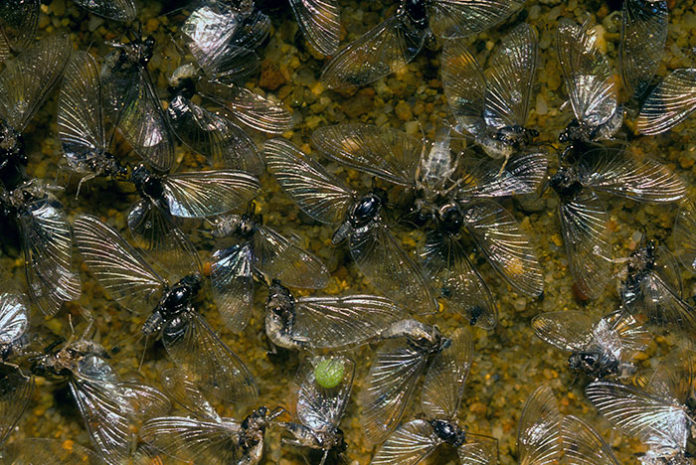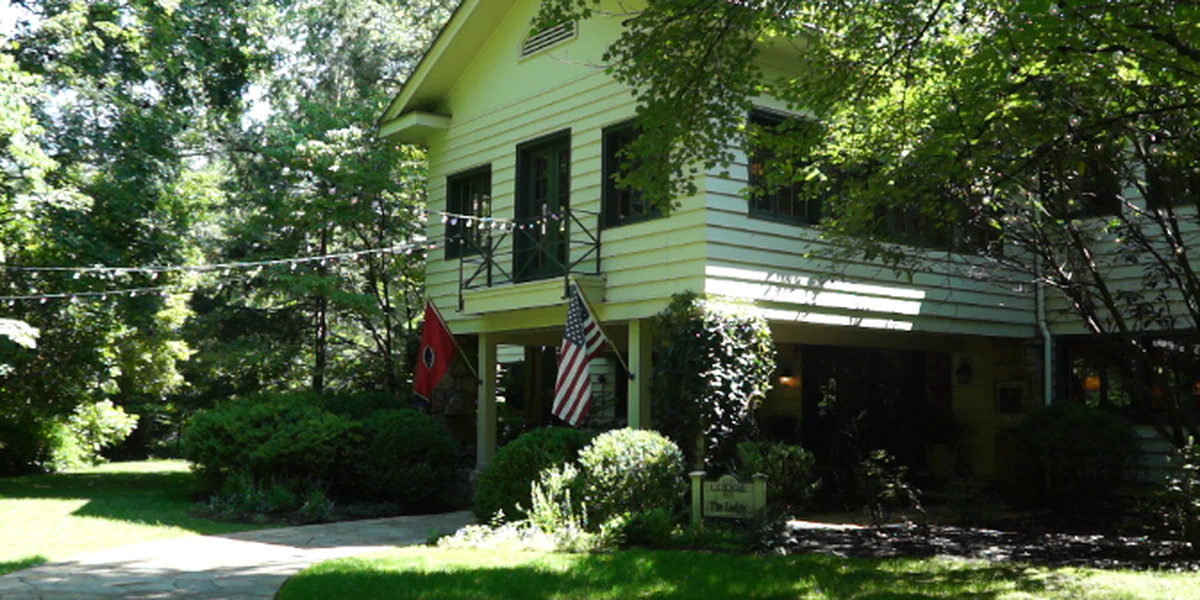Written by: Ted Fauceglia
Tricos produce some of the largest spinnerfalls of the season.
Photos by Ted Fauceglia
[Editor’s note: Ted Fauceglia is the country’s foremost photographer of aquatic insects, and he writes the “Natural Reflections” column in each issue of American Angler. Ted is also an FFI Certified Casting Instructor, the author of Mayflies (2004), and he has provided the bug and fly-pattern photography for dozens of books. He has graciously allowed us to republish some of his columns, and we will be sharing Ted’s incredible images and fly-fishing knowledge every month.]
If the fly fisher’s lexicon were ever available in written form, the unknowing reader would be amused, if not astounded, by the twisted definitions and associations fly fishers have ascribed to a certain group of words. Blue dun, blue quill, blue-winged olive, silver doctor blue, super-fine dubbing, stiff butt, supple tippet, green, brown, and yellow drakes, march brown, white-gloved howdy, woolly buggers, cowdung, cream variant, cocky variant, stimulator, freestone and limestone are but a few of the words that we have redefined for our purposes. To the average reader, I’m quite sure the words stiff butt would not stir visions of the fat part of a tapered leader nor would a stimulator rouse thoughts of a heavily hackled dry fly.
On the flip side, calcium carbonate does not immediately come to mind when we fly fishers hear the word limestone. True to form, we think of the word in an entirely different context, which A. Joseph Armstrong perfectly describes in Guide to Pennsylvania Limestone Streams, “Mention [limestone] to a trout fisherman and you’ll get a flood of associations—exquisitely clear pictures in sharp focus flashing like a slide show in fast forward. Watercress. Dimples. Blizzard like hatches. Seductive currents. Fat trout!” An esoteric vision, to be sure.

The unique profile of the Trico spinner has spawned countless imitations.
Having made many trips to most of Pennsylvania’s limestone waters, I share Mr. Armstrong’s imagery of limestone waters. Limestone streams represent the fly fisher’s ultimate challenge. Fertile water, with constant flows, that produce picky, healthy, wild trout rising in the cross currents of exposed vegetation, feeding on a plethora of insects.
Like most of the Pennsylvania’s fertile freestone streams, not all of her limestone waters produce every major hatch. But olives, blue quills, Quill Gordons, Hendricksons, green, brown and yellow drakes, sulfurs, most of the members of the light Cahill family, Tricos, the white fly and a host of terrestrials including the ubiquitous common black ant do occur on the majority of PA’s limestone waters. In addition, substantial hatches of caddis and stoneflies occur annually. To successfully meet these hatches, light rods, fine tippets, precise spot casts combined with the right patterns are the order of the day.
Many Pennsylvania limestone anglers, including yours truly, feel that the sulfur hatches present the best dry-fly action of the season. Starting around the last of May, the first of the sulfur hatches emerge. Later in May, several sulfur species hatch sequentially that produce excellent dry-fly action from the end of May to the beginning of July.
Unfortunately, wild trout and prolific mayfly hatches inherently carry a downside—crowded conditions. When the sulfurs are on, crowded conditions are a given; it’s axiomatic to say you’ll have a lot of company. It’s something that has to be dealt with, if you want to fish the sulfurs. But despite the throngs of mad casters, I am inexorably attracted to the sulfur hatches. The action is just that good.
Ironically, there is a positive side to the end of the sulfur hatches–when the sulfurs hatches subside, so do the crowds. By the first of July, the throngs of mad casters are reduced to a fervent few. Almost overnight, the feverish pace slows remarkably. The early morning mad dash to the stream is not necessary; the parking areas are empty; and your favorite sections of the stream are available. The large pods of rising trout have dissipated. But the trout are still there, and more hatches are coming.

Trico Spinner (female)
Hook: 1X-fine straight-eye hook (here, a Tiemco 101), sizes 20-26.
Thread: Olive, 12/0.
Tail: Light dun Microfibbets.
Abdomen: White thread, 8/0.
Wing: Hi Vis Antron, white.
Thorax: Black Superfine dubbing.
Head: Black tying thread.
Tricos
The last sulfur dun emerges sometime in the middle-to-late June. By this time, most of all the major mid-morning early season hatches have completed their life cycle. With rising air temperatures and reduced water levels, Mother Nature has made some critical adjustments: hatch-times have been revised, and the molting process has been accelerated. Adult mayflies do not have mouthparts; and consequently, they do not have any means of absorbing water. If exposed to the sun for any period of time they die–immediately. To the mayfly, exposure to the hot sun is equivalent to confinement in a gas chamber. They are not equipped to deal with the sun’s heat. Much worse than sunburn, they quickly dehydrate. To cope, late summer mayfly species have simply changed their hatch times. Some species hatch before the sun rises, while other species wait until the sunsets. Tricorythodes (Tricos) and the White Fly (Ephoron species) species reflect this adaptation. Tricos hatches occur before the sun comes up and the White Fly hatches after the sun goes down.
Depending on the conditions, Trico spinners can be on water from daybreak to as late as 10:00 A.M. Trico males emerge during the night. After hatching, they travel to the nearby foliage where they molt into spinners. Females hatch shortly before daybreak. After a short resting period, the females fly to a chosen section of the stream (usually at the head of riffle or pool) where the males join them, and the mating process take place. Because hatching activity takes place during the night, dun patterns are the least effective pattern. Some hatching activity lingers into the day light hours; but by and large, the spinner patterns work best. Trout lie at the tail end of pools and gulp the dying spinners as they drift into their feeding lanes. Size and pattern are critical. Trico hatches begin in early July and stretch well into late October. Needless to say, the longer the hatch, the more selective the trout become.
Tricos have disproportionately large wings relative to the size of the bodies. The triple-wing spinner, created by Michigan angler Dr. Dave Ellis, perfectly matches a spent Trico’s profile. I rely on two spinner patterns one that represents the male, the other the female; I tie them in sizes 20 thru 26. The male pattern calls for an all black body, and the female pattern requires a very light green gray abdomen.

White flies molt very quickly before falling to the surface as spinners.
The White Fly
Long after the Trico hatch has ended and the sun has set, the white fly nymphs crawl out of their niches and prepare to hatch. Just before dark, the heavily gilled white fly nymphs wiggle to the surface where they immediately hatch into duns. After completing the molting process, the mating begins. From this point, it’s business as usual: the males fall to the water and expire, while the females descend to the water and deposit their eggs. When egg laying is completed, the females drop to the water. Emergence, mating and egg laying happen in a two-to-three hour period.
Like the Trico hatches most of the trout’s feeding activity centers around the spinner fall. A nymph pattern is useful prior to emergence and a dun pattern works during emergence, but the spinner represents the main course. A literal feeding frenzy happens when the spinners hit the water. During the height of the spinner fall, thousands of spinners blanket the water, and the trout noisily eat them. Typically, the trout line up in the best feeding lanes where the spinners drift directly to them. And while the trout will seemingly take any natural they see, they will not take just any pattern presented. Even when it’s pitch dark, they can be unbelievably selective. Under these circumstances, the best strategy is to zero in on a single rising trout, time its rise intervals, and cast when you anticipate the next take. If a rise occurs in close proximity to your fly, gently lift your rod. If not, keep trying. Futilely casting to hundreds of rising trout has been proven to cause a malady similar to whirling disease. Concentrate on one riser at time.

White Fly Spinner
Hook: Standard dry-fly hook (here, a Tiemco 100), sizes 12-14.
Thread: White, 8/0 or 70-denier.
Tail: Dun Microfibbets.
Abdomen: Mixture of white and light gray Antron dubbing.
Wingcase: Light dun Poly Yarn.
Thorax: Mixture of white and light gray Antron dubbing.
Head: White tying thread.
Simple, durable patterns work best during the spinner fall. Tying flies on in pitch-dark conditions, with trout rising all around me, is not one of my favorite past times. A single fly should endure the abuse of at least a dozen takes. The pattern shown below is my favorite White Fly spinner pattern. I also carry a light-dun parachute pattern tied with a light-dun poly yarn post. To improve accuracy, I use a leader shortened to seven and a half feet with about two feet of 5X tippet.
Unless you live near the stream and head home after the Trico hatch has ended and return in the evening to fish the white fly, you’ll have a long wait between the hatches. Fortunately, for those of us that travel long distances to fish limestone water, Mother Nature has again thought of us. In late summer, the terrestrial season is in full swing. And while pods of trout are not actively up and rising, a fortuitous supply of terrestrials find their way into the water. A well-placed terrestrial, like a black ant, will usually coax a resting trout out of its afternoon lethargy.
For the traveling angler, fishing the Trico and white fly hatches is easily an all-day affair–You must get to the stream early and stay late. It’s a good idea to bring a lunch, lots of drinking water and a tube of sun block—that late-summer sun is a killer.

Black Ant
Hook: Parachute hook (here, a Tiemco 102 Y), sizes 16-20.
Thread: Black, 8/0 or 70-denier.
Abdomen: Black fur dubbing.
Wing: Light dun Z-Lon.
Legs: Grizzly hackle.
Thorax: Black fur dubbing.
Head: Black tying thread.
Credit: Source link































